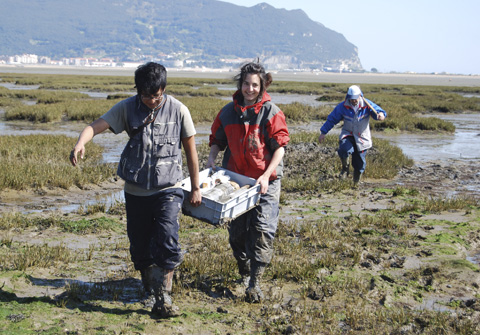Saltmarshes cushion the energy of the waves and act as natural barriers against high-energy climate phenomena. That is why restoring the currently occupied saltmarshes could be a cost-effective adaptation strategy to counteract the effects of the rise in sea level. This is one of the conclusions of a piece of research led by the UPV/EHU and which sets the time needed by several saltmarshes on the eastern Cantabrian coast to regenerate at less than 10 years.
Restoring saltmarshes, a cost-effective strategy to counteract the rise in sea level
A piece of research led by the UPV/EHU-University of the Basque Country has shown that in only 10 years it is possible to regenerate some of these coastal wetlands on the eastern Cantabrian coast
First publication date: 14/06/2016

In the current scenario of global warming and the acceleration in the rise in sea level, "the study of the saltmarshes is of great interest in developing adaptation strategies to tackle the consequences of climate change in the coastal area", explained Ane García-Artola, researcher in the UPV/EHU's Department of Stratigraphy and Palaeontology and who is currently on a post-doctoral internship at the Rutgers University (USA). She is the lead author of the paper Agricultural fingerprints in salt-marsh sediments and adaptation to sea-level rise in the eastern Cantabrian coast (N. Spain), published by the Estuarine, Coastal and Shelf Science journal. The UPV/EHU lecturers Alejandro Cearreta and María Jesús Irabien, as well as researchers at East Carolina University and the National Autonomous University of Mexico also participated in the work.
On the eastern Cantabrian coast many of these coastal wetlands had been occupied for agricultural purposes since the 17th century and in particular from the second half of the 19th century onwards until the 1950s when agricultural activity experienced a decline. The lack of dyke maintenance allowed water from the estuary to enter and it invaded these zones that had been artificially cut off, thus encouraging them to regenerate and be recolonised by halophytic vegetation, in other words, of the type that can survive in saline environments.
This work explored the regeneration process of the saltmarshes located in the Santoña, Plentzia and Urdaibai estuaries using the variation in the abundance of typical salt-marsh microfossils (foraminifera) and the sand content. "The agricultural horizon could be identified by the almost total absence of microfossils, whose number gradually increased during the regeneration process until becoming highly abundant once the saltmarsh had already regenerated," explained Garcia-Artola. At the same time, the sand content increased as the regeneration took place, which indicates a greater tidal influence on the saltmarsh as the environment was being restored.
To be able to work out the age of the sedimentary layers and determine the build-up rates, the activities of short-lived radioisotopes, pollution peaks and historical aerial photography were analysed. From a regional perspective, the environmental regeneration of these three saltmarshes took place mainly in the Santoña estuary between 1950 and 1960 and in some zones, even before the 1940s; between 1950 and 1960 in the Urdaibai estuary; and, finally, from the 1970s and 1980s onwards, in the estuary of Plentzia. In all the cases, the regeneration process was very fast (less than 10 years), owing to the high rates of sedimentation that took place (14-18 mm per year). The availability of abundant sediment material in the estuarine waters was crucial in the regeneration of the saltmarshes.
The study of the environmental transformation of these coastal zones is crucial when it comes to making predictions about the coastal evolution of the region. So the saltmarshes on the eastern Cantabrian coast are expected to adapt to the increase in the ongoing rise in sea level (1.9 mm per year during the 20th century), bearing in mind the high sedimentation rates observed during the regeneration process of the previously occupied areas. "The restoration of currently occupied saltmarshes in temperate zones with an abundant input of sediments could be put forward as a strategy of cost-effective adaptation to counteract the effects of the rise in sea level," pointed out Ane García-Artola.
Bibliographical reference
García-Artola, A, Cearreta, A, Irabien, MJ, Leorri, E, Sanchez-Cabeza, JA, and Corbett, DR, 2016. Agricultural fingerprints in salt-marsh sediments and adaptation to sea-level rise in the eastern Cantabrian coast (N. Spain) Estuarine Coastal and Shelf Science 171, 66-76. http://dx.doi.org/10.1016/j.ecss.2016.01.031

